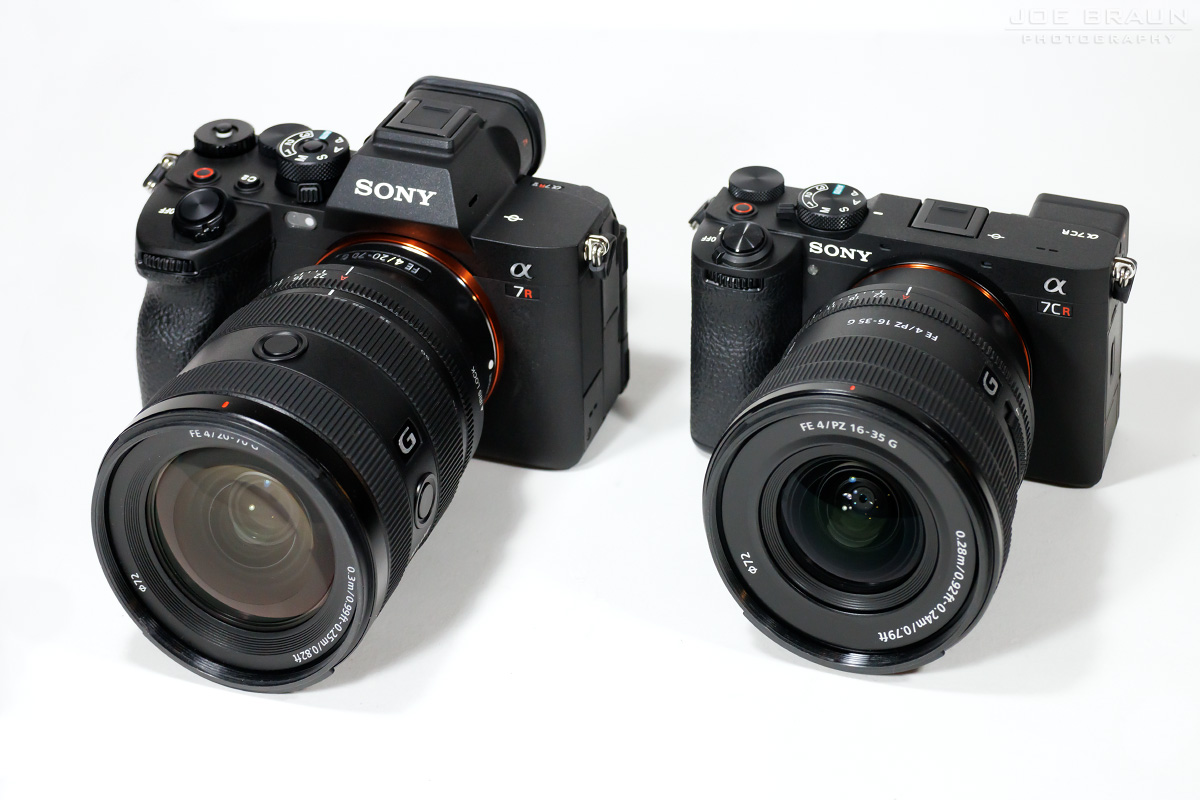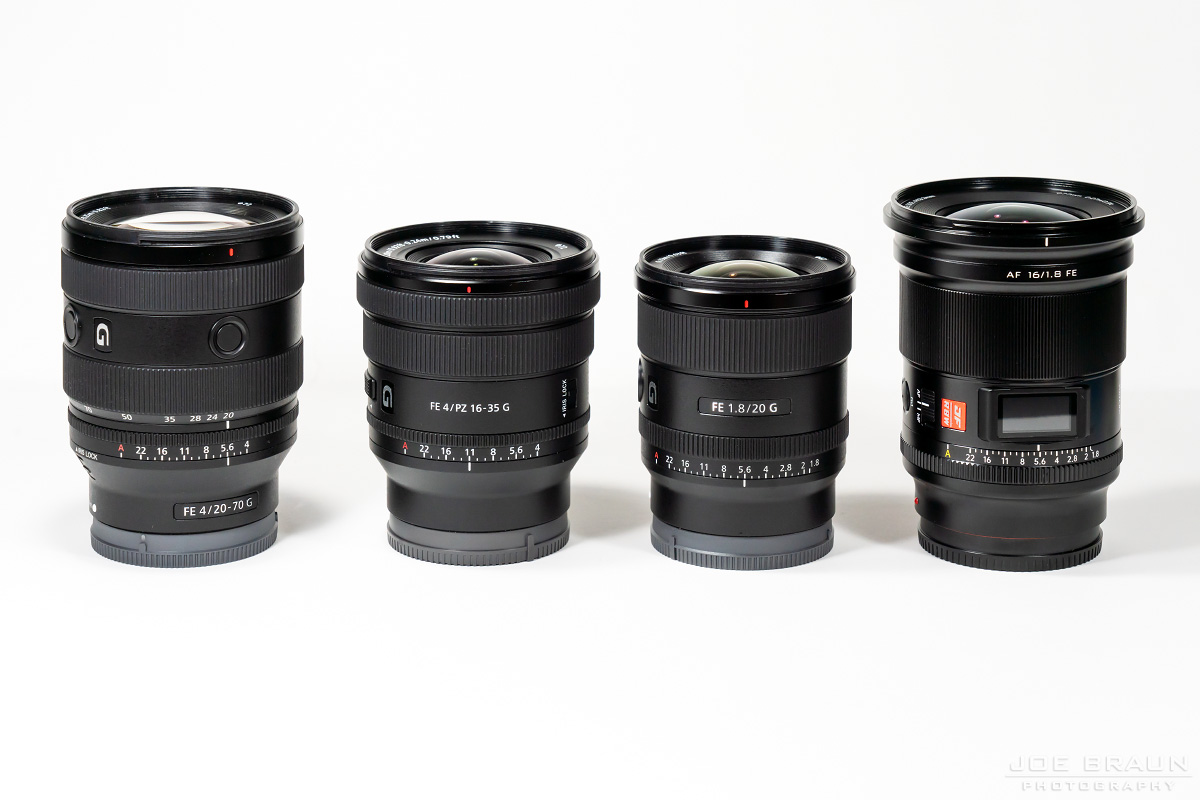CAMERA EQUIPMENT
People often ask me what camera gear I use, so I thought it would be fun to do a little write-up. As a landscape photographer who loves hiking, backpacking, and canyoneering, I have found myself constantly trying to balance the pursuit of better image quality (higher resolution and more dynamic range) with my desire to carry the smallest and lightest gear on my adventures. Every piece of camera equipment is some sort of compromise between size, image quality, and price. While I will be discussing my joy with Sony cameras on this page, I have also worked with Nikon, Canon, Fujifilm, Panasonic, and Olympus gear, all with great results. Whatever camera system you carry, take the time to learn the features of your equipment until it feels like an extension of your eyes and your hands. (Updated Fall 2024)
 |
Sony A7 "R" Series Full-Frame Mirrorless Cameras:
After shooting with bulky dSLRs for many years, I was thrilled to see Sony come to market with their A7 series cameras--the smallest and lightest high-resolution full-frame mirrorless cameras available. There is also a vast ecosystem of lenses to choose from, including many unique offerings from third-party manufacturers. Even though Nikon and Canon have gone mirrorless as well, minimizing size and weight for hiking photographers has not been their priority.
These days my go-to cameras for landscape work are the full-featured Sony A7r5 and the compact Sony A7Cr. Both cameras feature the same high-resolution 60mp sensor for spectacular image quality and dynamic range, especially when shooting RAW. While the A7r5 features a large viewfinder, fully articulating screen, extra controls, and a multi/micro terminal for intervalometer control, the A7Cr is the perfect camera for travel photography when you want to go as small and as light as possible.
 |
| The 60mp Sony A7r5 side-by-side with the smaller but equally high-resolution Sony A7Cr camera. |
Favorite Wide-Angle Lenses:
- Sony FE PZ 16-35mm f/4 G: Sony has released many wide-angle zooms in its day, so when this lens dropped in 2022, I was a bit surprised at how excited I was. This is now the smallest and lightest 16-35mm zoom on the market and it is exceptionally sharp even in the corners, perfect for hiking photographers who want to go light! This lens has an internal zoom-by-wire which I thought would annoy me, but I really don't care. I love taking photos with this lens; it blows the old Sony/Zeiss 16-35m f/4 out of the water. (The more expensive Sony FE 16-35mm f/2.8 GM is brighter and arguably sharper, but I do not enjoy taking such big lenses out on big hikes.)
- Sony FE 20-70mm f/4 G: Another newer lens that surprised me with its release in 2023, this may seem like a standard zoom, but instead starting at 24mm at the wide end, it starts at 20mm, effectively making it a wide angle AND standard zoom lens. When I have to go as light as possible and shoot with only one lens, I will bring the 20-70mm. It's light, it's small, and yes it's also sharp. Perfect! I find myself reaching for this lens more than my old workhorse, the better (and bigger) Sony FE 24-105mm f/4 G OSS.
- Sony FE 20mm f/1.8 G Lens: While I love the convenience of zooms, this small and light prime is a fantastic wide-angle lens, sharp throughout the frame and perfect for astro/night photography. I owe many of my best night shots to the performance of this lens. (The Sony FE 24mm f/1.4 GM is amazing as well, but I personally enjoy the wider 20mm.)
- Viltrox FE 16mm f/1.8: I was pretty skeptical when this cheaper third-party lens was announced in 2023, but to my surprise, this lens is amazing! Corner-to-corner sharp with great handling and a unique electronic display, this is a fantastic ultra-wide-angle prime for astro/night photography.
- Sony FE 12-24mm f/4 G Lens: A fun ultra-ultra-wide-angle zoom that is also corner-to-corner sharp. But since this is a bigger lens and it has a round front element and cannot take filters, I save this one for architectural work where I have to squeeze in as much of the scene as possible. I don't think I would ever choose to bring this lens on a hiking adventure. (Sony also makes a bigger and brighter 12-24mm f/2.8, but the size and cost aren't worth it to me.)
 |
Other Favorite Lenses:
- Sony FE 24-105mm f/4 G OSS: This is a wonderful standard zoom lens perfect for general use and for travel photography. While I now may reach for the 20-70mm lens (listed above) more than the 24-105 at this point, this is still a wonderful lens that's a good choice as a single lens solution. It's versatile and sharp throughout the range and not too big and heavy. As an added bonus, this lens renders beautiful light rays when pointed at the sun.
- Sony FE 90mm f/2.8 Macro G OSS: This is another one of my favorite FE lenses; it is a tack-sharp macro lens that can also do double duty as a portrait lens. It also has convenient controls for turning optical stabilization on/off, limiting focus distance, and switching between auto and manual focus.
- Sony FE 70-300mm f/4.5-5.6 G OSS: Variable aperture 70-300mm zooms might not be brightest or most exciting lenses on the planet, but this is a wonderfully sharp travel telephoto zoom. OSS does a terrific job of allowing you to handhold many shots even at relatively slow shutter speeds and I am pleased with the resolution for one of Sony's older lenses.
 |
A beautiful corner of the Zion Narrows bathed in golden light.
Sony A7r3 with Sony FE 16-35mm f/4 ZA OSS. |
Tripods and Accessories:
For tripods, I typically travel with two types: a big sturdy one for more "serious" work (like sunrise/sunset shots, time exposures, etc.) and a smaller, lighter one for use on strenuous hikes when keeping weight down is important. While there are many big names out there from Gitzo to Manfrotto, I'm a big fan of the relatively unknown Asian company, SIRUI. The Sirui N-1004SK Tripod is a reliable main tripod that easily supports a big heavy camera and features a removable monopod and interchangeable middle columns. The Sirui T-005KX Tripod is a good backpacking tripod when you want to go small and light, but it's a bit short and wobbly for taking long time exposures. As for lens filters, I often use circular polarizers and sometimes use ND (neutral density) filters to take longer exposures. Polarizers can often make the sky more dramatic, bring out details in clouds, and remove unwanted reflections in water, but in wrong situations, they can also negatively make water look too lifeless or turn the sky into an ugly and uneven dark blotch on wide-angle shots.
 |
Between the granite walls to the boulder beach...
Sony A7r3 with Tamron 17-28mm f/2.8 at 17mm. |
Conclusion:
If there is one thing I have learned over the years, it's that you can get great results from just about any camera system if you're willing to study it and make it work for you. And while it's always fun to look at and fantasize about the latest gear or debate which brand is better than the other, remember that it's not just about gear! Technique and composition make the difference. Below are some of my favorite images listed with the random gear that was used. Whatever camera equipment you use, get out there and have fun!
Wahclella Falls in the Columbia River Gorge.
Nikon D810 with Nikkor 18-35mm f/3.5-4.5G at 18mm. |
A beautiful night sky glowing above the Point Betsie Lighthouse.
Sony A7r3 with Sony 20mm f/1.8 G FE. |
Sundown at Olmsted Point, Yosemite National Park.
Canon M6 with EF-M 55-200mm f/4.5-6.3 IS STM. |
High water at the Barton Dam.
Sony A7r3 with Tamron 17-28mm f/2.8 at 19mm. |
Rappeling in the golden light of Pine Creek, Zion National Park.
Fujifilm X-E2S with 14mm f/2.8. |
Magical light show above Western Point, Acadia National Park.
Nikon D800 with Nikkor 14-24mm f/2.8 at 14mm. |
Pink winter sunset under Chapel Rock.
Fujifilm X-T2 with XF 18-135mm at 24mm. |
CitrusMilo Adventures HOME











